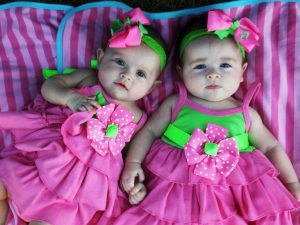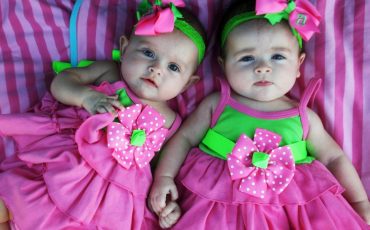 Although young girls have long played dress up, paraded around at home in their mother’s high heels, and nagged for sweets in grocery store check-out lines, only in the last couple of decades have they constituted a new marketing niche known as tweens. No longer defined in the advertising world as a child, yet not quite a teenager, girls in the 8–12 age range have captured the attention of fashion and beauty businesses, seeking brand loyalty from the Y generation. Key to corporate success is the ability to sell teenage sensuality and attitude to preadolescent youth culture. Perhaps most symbolic of this shift is the rise of Bratz dolls, a sassy, street-smart makeover of Barbie that embraces not the cosmopolitan lifestyle of a single girl, but rather teenage moxie. While Barbie has increasingly become the play toy of three and four year olds, a whole host of manufactured teenage icons, ranging from Brittney Spears to Hannah Montana, has been selling everything from toys to fashion. However, tween culture is not simply about marketing bliss. As this newest stage of the lifecycle has become part of the everyday vernacular, tweens have troubled parental and consumer groups who worry that the youngest generation may simply be growing up too fast.
Although young girls have long played dress up, paraded around at home in their mother’s high heels, and nagged for sweets in grocery store check-out lines, only in the last couple of decades have they constituted a new marketing niche known as tweens. No longer defined in the advertising world as a child, yet not quite a teenager, girls in the 8–12 age range have captured the attention of fashion and beauty businesses, seeking brand loyalty from the Y generation. Key to corporate success is the ability to sell teenage sensuality and attitude to preadolescent youth culture. Perhaps most symbolic of this shift is the rise of Bratz dolls, a sassy, street-smart makeover of Barbie that embraces not the cosmopolitan lifestyle of a single girl, but rather teenage moxie. While Barbie has increasingly become the play toy of three and four year olds, a whole host of manufactured teenage icons, ranging from Brittney Spears to Hannah Montana, has been selling everything from toys to fashion. However, tween culture is not simply about marketing bliss. As this newest stage of the lifecycle has become part of the everyday vernacular, tweens have troubled parental and consumer groups who worry that the youngest generation may simply be growing up too fast.
Recent History
In some ways, selling beauty products and stylish clothes to tweens is not so new. Although unimaginable before World War II, baby boomers quickly came into their own as head-to-toe beauty consumers, easily finding everything from clothing stores for teenagers to magazine advice columns. By the late 1980s, a similar pattern began to take shape with a somewhat younger crowd. Shopping had already become an all-American past time, and suburban malls were seen as safe and exciting spaces for young girls to pal around with their peers and to try on the latest fashions. In the 1980s, with conspicuous consumption no longer a taboo, a younger generation of Madonna wannabes saw their embracing of the material girl as a means of empowerment, at least in the realm of consumption. At the same time, there were several factors that seemed to intensify the commercialization of childhood. Advertising to children was becoming ubiquitous; even public schools were no longer off-limits to advertisers. New FCC regulations, for example, allowed children’s cartoons to be transformed into advertisements designed to sell far more than just breakfast cereal. PBS children’s programming, for example, increasingly seemed to be teasers for the fast food and toy industries. The mass marketing of Teletubbies, Strawberry Shortcake, and the Care Bears paved the way for Bratz, Britney Spears, and the Backstreet Boys. In the 1990s, not only was tween consumption undeniable in shopping malls across the country, but market surveys found that tweens had surprising influence over the family expenditures, often outspending their teenage counterparts. Tweens were now a marketing factor to be reckoned with and experts in the fashion industry also relished their sophistication and brand loyalty. For the children of the well-to-do, it is no longer simply Hillary Duff but Louis Vuitton and Juicy Couture that capture their attention.
Parental Concerns
The commercialization of tweens, however, has renewed fears of exploitation. Stores often titillate tweens with pop aesthetics that mix the latest music with girlhood accessories that range from flavored lip gloss to bras. Claire’s, Justice for Girls, and Limited Too have had huge success, along with Abercrombie, a once teenage clothing store that has taken flak for marketing thong underwear to 10 year olds. The mixing of Webkinz (stuffed animals with virtual lives) and lingerie has struck many parents as disturbing. Preadolescent girls seem to have adopted more sensual styles of beauty and glamour associated with their teenage counterparts. They casually flip through the pages of Seventeen, once marketed to the age implied, and they follow the romances of 20-something actors who play high-schoolers in their favorite Disney movies. Some question whether kids are growing up too quickly thanks to Madison Avenue, or whether this is a recurring cliché that has troubled every generation since Vladimir Nabokov’s 1955 novel Lolita.
Since tween culture and consumption tend to be gendered female, a familiar and often uncomfortable double standard is easily resurrected. Although boys are also part of the tween market and are susceptible to the influence of the latest trends or complaints about baggy pants, hair length, and violent video games, protecting a girl’s virtue remains front and center of both public and private debates. Adding to that discourse are the latest scientific findings attempting to understand why American girls begin menstruating at increasingly younger ages. White American girls, on average, begin to menstruate at the age of 10, while for African American, girls the average age is now 9. Whether it is higher fat content in the American diet or the liberal use of hormones in dairy cattle, girlhood seems at risk and marketing to tweens demands balancing childhood dreams with parental anxiety.
Acquiescence
Despite a litany of concerns, marketing to tweens has been a tremendous success, bringing billions of dollars to the beauty industry. To understand what appears to be a parental contradiction, scholars define consumption as a complicated response to an ever-changing social economic landscape. Some have insisted that parental guilt has driven the pace of consumption. Thanks to family speed-ups that typically require mothers and fathers to work outside the home for longer hours, parents turn to shopping and presents as a quick fix when they cannot spend enough time with their children. At the same time, consumption is a process; mothers and daughters still shop, get their hair done, and frequent nail salons together. Planning a birthday party at a tween spa facilitates familiar kinds of conversation that in previous years helped organize a backyard get-together or sleepover. It is a shift in labor that is most profound. Mothers and fathers may hold the video camera, but in the commercial setting they do not have to provide the entertainment or the food or clean up. Again, the growth of tween culture is bound to larger changes in the political economy that also shape the adult world of work and responsibility. Amid a global recession, tween consumption may face some limits, but a shrinking pocketbook does not mean the end of tween culture. Tweens who have the kind of savvy to distinguish between knock-off and designer brands will more than likely piece together good bargains as they continue to hone their skills in the world of consumption and style.

Leave a Reply